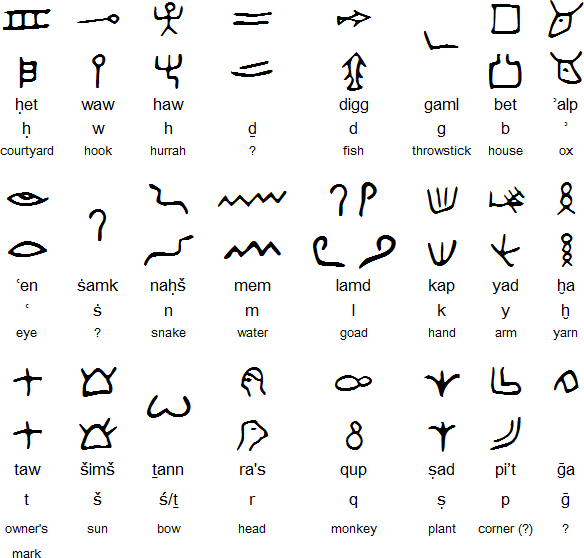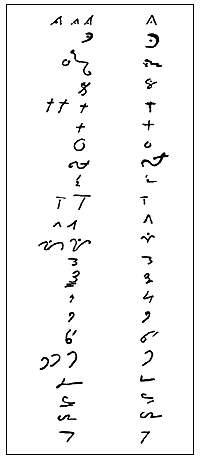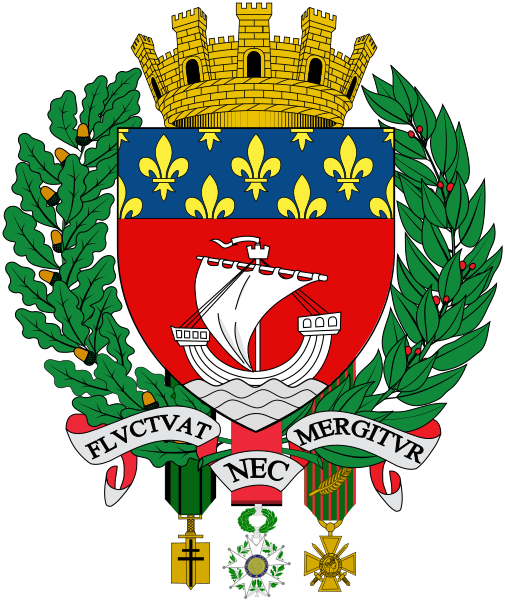There is a language that became extinct when LATIN language was created and IMPOSED as result of a POLITICAL DECISION by the rising ROME power that was to become ROME EMPIRE.
Sabellicus language was widely spread over ITALY (ITA + LIAh peninsula), inhabited by a people that had come from GREECE and that was speaking yet some of Phoenician language and writing in Phoenician characters even coming from inhabit Greece... Who was such people? In a collective way they were the SABELLICUS. They arrived mainly through Adriatic Sea/coast (middle to north) and maybe also walking through Venice region.
For sure some "old Latin precursor language" existed, in parallel with other ancestor languages, used by such Sabellicus languages (as Greek and Phoenician, what was to become German). But Sabellich was made extinct by political decision, by 5th century BC, by ROME, to exterminate the Sabellicus language showing evidence of link with Phoenician language, that was the proof that Romans and Italians had been slaves (Joel 3:6) of them and of Greeks.
Thus Sabellicus language and thus the Nephitic language (just a branch, of it, by the year of some 600 BC) was made extinct, erase, replaced by the classic LATIN language, created as a "branch language" of classic Greek language.
And all the true past history was replaced by fables and even some tells about some of the true history. As the one that tells the SABELLIS=SABINES (inhabitants of ITA-LIAh) were living as slaves in Greece and run away from it. They stole sailships with few women Sabelli and came to settle Italy and Rome town. Arriving there they "noticed" they had few women. They wanted to return and get more. But the women in sailship refused the idea and threatened to set fire on sailships. They told it was so silly idea, because it was plenty of beautiful women around. It was just the work of capturing them. Thus they made a party and made the "rapt of Sabines party": one of many tales for the foundation of Rome that replaced true history that they destroyed with all Sabelli's past, including language.
For knowing about the true CHARACTERS used by the NEPHITES from the time they departed from ITA-LIAh peninsula, from nearby Rome, have a look to what was the TRUE CHARACTERS they wrote on TOMBS of some 500-700 years BC, as in the region of ORVIETO, some 130 km far from ROME. The small village of NEP nearby it... There are plenty literature about TRUE characters written on stones and objects of such NEPH's period in Italy. You should examine a picture of one word that was engraved on stone of a tomb 500 BC and see it was written with same CARACTORS of Joseph Smith.
http://www.mormondialogue.org/topic/54967-1921-book-of-mormon-geography-hearings/page__st__80Message # 92
Old Italic alphabets
Origin
The Old Italic alphabets developed from the west Greek alphabet, which came to Italy via the Greek colonies on Sicily and along the west coast of Italy. The Etruscans adapted the Greek alphabet to write Etruscan sometime during the 6th century BC, or possibly earlier. Most of the other alphabets used in Italy are thought to have derived from the Etruscan alphabet.
"Ancient Latin"
The earliest known inscriptions in the Latin alphabet date from the 6th century BC. It was adapted from the Etruscan alphabet during the 7th century BC. The letters Y and Z were taken from the Greek alphabet to write Greek loan words. Other letters were added from time to time as the Latin alphabet was adapted for other languages.

Here in the character "A" we can see so strange type of "A" that are so frequently presented in the
Kinderhook plates. Some also are shown in CARACTORS document, but are rare cases.
They are quite like of very ancient Phoenician origin, never of Greek origin. They are the result of the slavery narrated in Joel 3:6, as the Greek used a well done and well shaped "A" character, not these barbarian and brute "A" from the Phoenicians. One general site on the ETRUSCANS:
http://www.mysteriousetruscans.com/Etruscan language -->
HAVE A LOOKhttp://www.mysteriousetruscans.com/language.htmlGOLD PLATES would look something like this: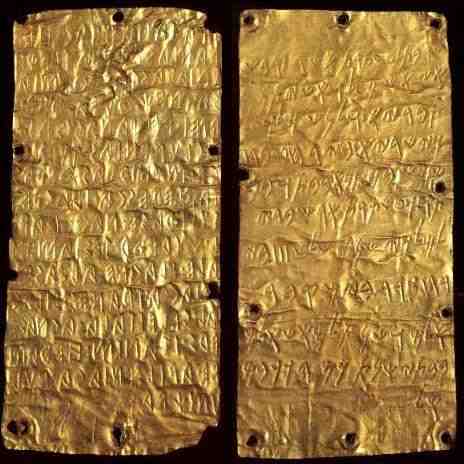
The Greek alphabet has been in continuous use for the past 2,750 years or so since about 750 BC. It was developed from the Canaanite/Phoenician alphabet and the order and names of the letters are derived from Phoenician.
At first, there were a number of different versions of the alphabet used in various different Greek cities. These local alphabets, known as epichoric, can be divided into three groups: green, blue and red. The blue group developed into the modern Greek alphabet, while the red group developed into the Etruscan alphabet, other alphabets of ancient Italy and eventually the Latin alphabet.
"A" character uses a "DOT" instead of the horizontal "bar" between two inclined lines. Very typical feature of the "A" characters provided in "CARACTORS" provided by Joseph Smith
These strange shaped A also appears in Kinderhook plates:

and in many other collections of Italic characters of 5 to 7 centuries BC, including for many other type of characters, even those quite strange ones. And that would appear to be very Phoenicians... But Sabellicus were not Greeks. And followed some Hebrew rules, even now they continue to follow. As on doubling characters.
http://www.omniglot.com/writing/greek.htm GREEK
ANCIENT GREEK - may have a link with NEPHITIC
 http://www.omniglot.com/writing/phoenician.htm
http://www.omniglot.com/writing/phoenician.htmPhoenician/Canaanite
Origins
The Phoenician alphabet developed from the Proto-Canaanite alphabet, during the 15th century BC. Before then the Phoenicians wrote with a cuneiform script. The earliest known inscriptions in the Phoenician alphabet come from Byblos and date back to 1000 BC.
The Phoenician alphabet was perhaps the first alphabetic script to be widely-used - the Phoenicians traded around the Mediterraean and beyond, and set up cities and colonies in parts of southern Europe and North Africa - and the origins of most alphabetic writing systems can be traced back to the Phoenician alphabet, including Greek, Etruscan, Latin, Arabic and Hebrew, as well as the scripts of India and East Asia.
PHOENICIAN ALPHABET
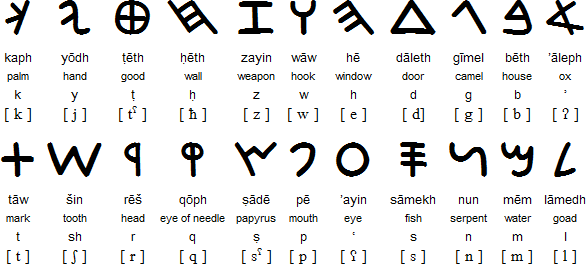
FIRST REFORMED EGYPTIAN LANGUAGE - CHARACTERS:
Proto-Sinaitic / Proto-Canaanite
The Proto-Sinaitic script was the first alphabetic writing system and developed sometime between about 1900 and 1700 BC. People speaking a Semitic language and living in Egypt and Sinai adapted the Egyptian hieroglyphic or hieratic scripts to write their language using the acrophonic principle. This involved choosing about 30 glyphs,
translating their Egyptian names into the Semitic language, and
using the initial sounds of those names to represent the sounds of their language.
http://www.omniglot.com/writing/protosinaitc.htm